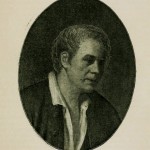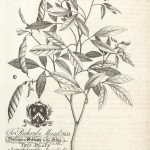Georg D Ehret Biography
The following information and excerpts are from an autobiographical article by Georg Dionysius Ehret written on the 27th of October, 1758, in Park Street, London. The article was translated by E.S. Barton and published in the 1895 Proceedings of the Linnean Society of London. The genealogy (family tree) chart is republished from the 1884 Proceedings of the Linnean Society of London, Zoology. Date with an * are estimated based the excerpts from the autobiography.
| Born | Heidelberg, 30 Jan. 1708 |
| Died | London, 9 Sept. 1770 |
| Parents | Anna Maria Ehret (mother), Ferdinand Christoph (father) and Herr Anton Godfried Kesselbach (stepfather) |
| Wife | Susanna Kennet (d. 1781) married in 1738 |
| Children | Has three children with with only a son surviving childhood. George Philip Ehret (1741-1786) who was educated at Oxford until 15 years old. He apprenticed as an apothecary and surgeon at Watford, in Hertfordshire and practiced as a surgeon. |
| Work | 1719-1721* Apprentices with father’s brother for 3 years in Bessungen, near Darmstadt 1722* Gardner for 1 year at the gardens of the Elector of Heidelberg 1723-1725* Journeyman Gardner for 3 years at gardener to the Margrave at Carlsruhe 1726* Painter for the apothecary Johann Wilhelm Weinmann in Regensburg for 1 year 1727-1731* Painter for the banker Leskenkohl in Regensburg for 5 years and completed three volumes of Hortus Malabaricus and also completes 560 paintings for his own portfolio, 1731* Sells the portfolio to Dr. Widmann and is also engaged by Christoph Jacob Trew to produce 80 large plates 1731* Visit Johann Ambrosius Beurer at the University of Altorf and Christoph Jacob Trew at Nuremburg 1732 Sends 80 plates to Trew from Regensburg 1733* Travels to Basel Switzerland and stays for one year to create a garden for Samuel Burckhardt 1734* Sends 12 plates to Trew from Basel 1734 Travels Paris taking the route of Berne, Lausanne, Geneva and then Lyons, Montpellier (remained 1 month), Milliau, Clermont and Paris 1734 Sends 3 plates to Trew from Montpellier 1734 Presents his letter recommendation from Dr. Eichrodt to MM. Antoine and Bernhard de Jussieu who house him in the garden-house at the Jardin des Plantes, stays for the winter and does work for M. le Marquis de Gouvernet and M. du Pay 1735* Sends unknown number of plates to Dr. Trew from Paris 1735 Travels to London, England on the recommendation of MM. de Jussieu and with a passport personally signed by the King of France (Louis XV) 1735 Travels to England on the recommendation of MM. de Jussieu and with a passport personally signed by the King of France (Louis XV) 1736 Sends 200 plates to Trew from London 1736* Travels to Leyden, Holland and visits Mr. Clifford in Haarlem and his house-guest Mr. Linnaeus 1736* Stays for a month at Haarlem creating plates for Mr. Clifford for Hortus Cliffortianus 1736* Returns to and settles in London, preferring the exotic plants found in the gardens of London 1738 Marries Susanna Kennet 1741 His son George Philip Ehret is born 1749 Begins to teach painting to the nobility of England 1750 Elected to the Botanic Garden of the University of Oxford 1754 Richard Mead, Royal Physician dies, and his collection of Ehret’s work is sold at auction for £36 (approx £6,550 in 2011 equivalent currency) 1757 Elected a Fellow of the Royal Society of London 1758 Baron Francis St. John’s collection of Ehret is sold at auction for two to three times their price brining the artist notoriety |
Excerpts From His Autobiography
“On account of the early death of my father, I was taken from school early and sent as a gardener’s apprentice to my father’s brother at Bessungen, near Darmstadt, where I had to do the most ignominious work during my three years of apprenticeship. The instruction in the art of drawing which I had received from my father (who was a good draughtsman)
I did not give up, notwithstanding the slavery during my apprenticeship, and employed all my spare hours in perfecting
myself in sketches. As I gradually improved in this art, my cousin employed me at the end of my apprenticeship to draw sketches for him in his room.”
“As this Sievert painted very beautifully in water-colours, which I had striven to do from my youth, I did all in my power to profit by this opportunity; but he never gave me any special instruction in this art, only employing me to grind the colours. In my leisure hours I sometimes tried to paint, and executed some tulips for the Margrave, who at that time had the greatest desire to have paintings of all his hyacinths, &c., and had appointed different painters for the purpose.”
“I had a letter of recommendation from Herr August Wilhelm Sievert to the celebrated Herr Detlef Simpson, gardener at Regensburg, asking him to help us; and Herr Simpson kept me there as I had learnt so little painting, in order, as he intended, to introduce me to the apothecary, Herr Weinmann, and banker, Herr Leskenkohl.”
“In order to cut myself off entirely from gardening, I completed in the five years a considerable collection of plants [560 paintings] growing round Regensburg, among them being many exotic ones. This collection was made known through the late Herr Beurer, a new acquaintance of mine who was beginning his studies [as an apothecary] towards the end of my stay in Regensburg. He admired my collection, and asked if I would not sell it, as he could perhaps find me a patron, and asked what I wished to obtain for it. I made up my mind at last and sold the collection(how many hundreds there were of them I have quite forgotten) to Herr Dr. Wiedmann of Nuremberg.”
“Through this, my first transaction of the kind, I had at the same time the honour of making the acquaintance of the learned Dr. Trew, in order to paint plants for him, and I continue to do so, through God’s help, up to the time of writing these lines, May 15, 1758. […] Through this personal acquaintance with the venerable Dr. Trew [in Nuremberg], I went more deeply than ever into botany and painting.”
“I also took a journey to Amsterdam, to see everything in the Botanical Garden there. The Dutch gardens did not please
me as well as those in England, which are full of rare plants. I journeyed then again to England, and as the Musa fructii cacumerico longior belonging to Baron Joseph Ayloffe was blooming, in the year 1786 I drew it for him and engraved it on copper.”
“In thee year 1737, in August, the Magnolia flora ingenti candido was blooming in the garden of Mr. Charles Wager at Parsons Green, near Fulham. I went there nearly every day from Chelsea to Parsons Green, whicii is about 3 miles distant, to observe tbe plant from its first bud and what might come (there were no more) till the flower was quite complete. I drew every individual part of it in order to publish a perfect botanical plate; and I was the first to observe the characters of it minutely, and my valued patron. Dr. Trew, liaa made me through this not a little known in the Commercia Litteraria.”
“It happened that when this plate was finished, I went to Lord Petre’s garden to find something new. This gentleman was building the largest glass-houses in England, if not in the world. (See my Tab. 3, the large house for the Papaya, which stands quite free therein.) His property lies 15 miles from London [at Brentwood], close by the great road which goes from London to Harwich, where all the foreigners from Holland and London cross the sea. I remained there some days, and collected many rare specimens ; and on my return to London I left them at an inn near Lord Petre’s garden, to be sent on by the first coach to London.”
“Some years after I came to England I became acquainted with the excellent Dr. Mead, Royal Physician, who engaged me; and I prepared for him, from time to time, paintings of rare plants, mostly with a description of them, on great folia of parchment, at one guinea apiece. The number of them reached at last 200. This work, over which I spared no pains, was not kept secret by Dr. Mead, as by others, but he showed it to everyone in order to bring me on in the world, and made suggestions for disposing of my work at sales, as many painters have done.”
“In the year 1749 I began to give instruction in painting of plants and flowers to the highest nobility of England ; and in my whole life I have not been so prosperous as during the last years, God be thanked I. Although I accepted the post in Oxford in 1750, my intention was to publish plants on my own account (because the salary was not large) in order to earn more money; and I intended, if this proved successful, to give up all my pupils. But my pupils were glad when I came back; indeed, they w^ere much more eager to have me than before. It I could have divided myself into twenty parts I could have had my hands full. I recommended all those to whom I gave instruction to lay all the plants, that they did with me, into books. Now, in these eight years some of my pupils made collections of 100. Yes, some even finished 2, 3, and 4 times as many; and on each sheet were added the right botanical names. This all took place under my direction; and there had never been anything of the kind in England before.”
| Publication | Series | Amazon | B&N | Magcloud |
| Ehret & Haid London Botanical Illustrations | delsc | Available | Available | Available |





